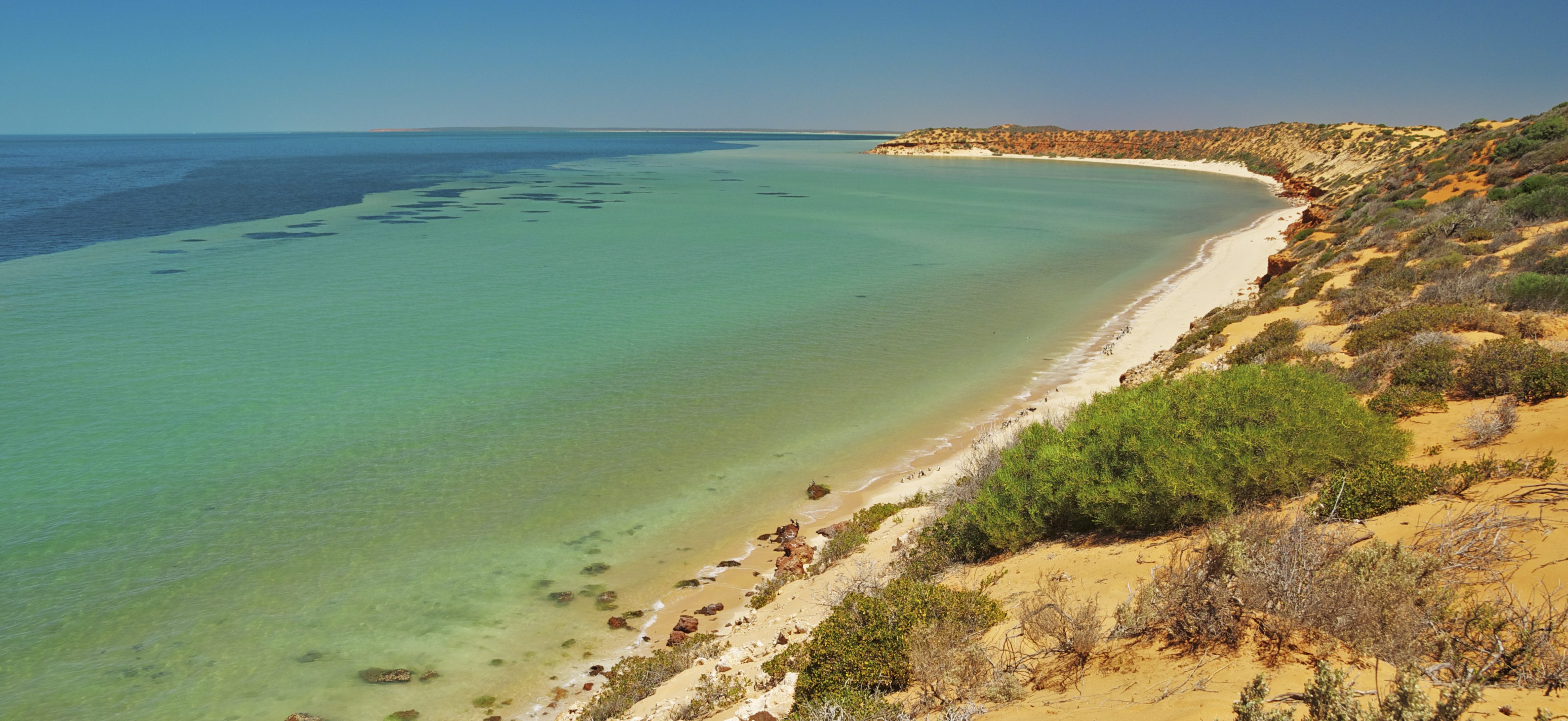Large numbers of dugongs, sea snakes and other marine animals disappeared from the UNESCO World Heritage Site Shark Bay, Western Australia, after a heat wave devastated seagrass meadows, according to recently released research.
The reasons for the population losses, however, differed among species, according to Rob Nowicki, an FIU alumnus and postdoctoral research fellow at Mote Marine Laboratory.
“Essentially we found that, for most species, when you lose the seagrass resources you lose a lot of the animals, but the nature of how they get lost — for instance, whether they starve or leave — and the degree to which you lose them differs by species,” Nowicki said. “Dugongs, which have to eat seagrasses, and sea snakes, which use it for foraging and refuge, were really hard hit.”

Shark Bay, Australia
The findings offer insight into how some vital ecosystems may change in a warming climate. Nowicki was a Ph.D. student during the 2011 heatwave studying under biological sciences professor Mike Heithaus, now dean of the FIU College of Arts, Sciences & Education. For more than two decades, Heithaus has led the most detailed study of the ecological role of sharks in Shark Bay collecting extensive data that provided the perfect baseline to assess the impacts of the extreme climate event.
“We started the Shark Bay Project in 1997 to understand how pristine ecosystems work and how important big animals are to healthy oceans,” Heithaus said. “Twenty-two years later, we are seeing what happens to this once-pristine ecosystem faced with an extreme climate event. Our oceans are under stress from what seems like from all angles and we’re finding these heatwaves may push systems into degraded states they struggle to recover from.”
Previously published research by the team, which also included FIU research specialist Kirk Gastrich, showed Shark Bay’s dominant seagrass species, Amphibolis antarctica, declined and failed to rebound significantly in the few years following the heatwave. In some spots it was replaced by smaller, tropical Halodule uninervis seagrass — somewhat like replacing a forested canopy with a mowed lawn. The Amphibolis seagrass creates habitat and food, slows down water currents and clarifies the water. With the loss of that particular species of seagrass, those functions were also lost.
The team, which also included partners from Deakin University in Australia, Nova Southeastern University in Florida, and the University of Washington, analyzed shark data from some 27,052 hours of catch-and-release fishing across 414 days between 1998 and 2015, including 95 days after the seagrass die-offs. They also analyzed data from 3,375 transect surveys, including 714 after the seagrass die-off, which documented 22,371 animals of multiple species.
Key findings include:
- Fishing surveys showed tiger sharks and then sandbar sharks the most common of the 16 shark species found during the study. While their numbers generally did not decline after the seagrass die-off, the tiger sharks caught afterward were smaller on average and likelier to be male. Tiger sharks are “generalists” that can feed on a wide variety of animal species, and their flexible feeding was expected to support their survival amid environmental change.
- Another generalist feeder, the loggerhead sea turtle tends to find prey in areas with reduced seagrass cover and may have benefited — at least temporarily — from seagrass loss. Their numbers remained stable and they were spotted more often in shallow areas with more accessible prey but greater risk from sharks, even if sharks continued to be documented nearby.
- Indo-Pacific bottlenose dolphin sightings declined about 40 percent after the seagrass loss, for reasons that remain unclear. This species tends to live within a stable “home range” and may move temporarily during extreme climactic events, but the recent heatwave didn’t exceed the temperatures this species can encounter in other parts of its range and didn’t account for their prolonged decline. The dolphins feed in seagrass beds but are not solely dependent on them.
- Pied cormorant birds primarily eat fish in seagrass beds, and this may help explain why their abundance declined 35 percent after the seagrass die-off. Some of these relatively mobile birds might have left the area once food sources declined.
- Green sea turtle abundance declined 38.6 percent, and emaciated green sea turtles were documented repeatedly. Seagrasses are a substantial part of the species’ diet, and scientists suspect that some turtles may have died from starvation or from a weakened ability to avoid predators.
- Dugong abundance declined 67.5 percent after the seagrass die-off. These cousins of manatees must eat seagrasses to survive and have previously been documented to leave depleted areas. Their departure was considered likelier than starvation.
- Sea snakes (multiple species) were hardest hit, declining in abundance by 76.7 percent. They depend heavily on seagrass beds for protection and hunting but can have extremely small home ranges, suggesting they were less likely to relocate and more likely to perish — either from starvation or from increased predation.
The declines in abundance of dolphins, cormorants, green sea turtles, dugongs and sea snakes were all statistically significant, meaning that they were highly unlikely to occur by chance. While this type of study cannot prove definitively that the seagrass loss drove these major changes — and the experimental setups needed for that proof are challenging to implement in the ocean — the study strongly suggests seagrass loss was a problem for these animals, based on many past studies of the animals’ life history, relationships to seagrass beds and to one another.
In more developed regions, seagrass habitats face not only climactic events, but local stressors including pollution. Nowicki says that minimizing local stressors, such as nutrient pollution from fertilizer runoff into bays and estuaries, may give seagrasses — and in turn, the animals they support — better odds amid climate change and other global stressors. The findings were published this week in EcologicalMonographs.
